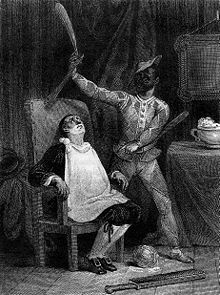
The Barber of Seville or the Useless Precaution[1] (French: Le Barbier de Séville ou la Précaution inutile) is a French play by Pierre Beaumarchais, with original music by Antoine-Laurent Baudron. It was initially conceived as an opéra comique, and was rejected as such in 1772 by the Comédie-Italienne. The play as it is now known was written in 1773, but, due to legal and political problems of the author, it was not performed until February 23, 1775, at the Comédie-Française in the Tuileries. It is the first play in a trilogy of which the other constituents are The Marriage of Figaro and The Guilty Mother.
Though the play was poorly received at first, Beaumarchais worked some fast editing of the script, turning it into a roaring success after three days. The play's title might be a pun on Tirso de Molina's earlier play El Burlador de Sevilla (The Trickster of Seville).
Mozart wrote a set of 12 variations, K. 354, on one of Baudron's songs, "Je suis Lindor".